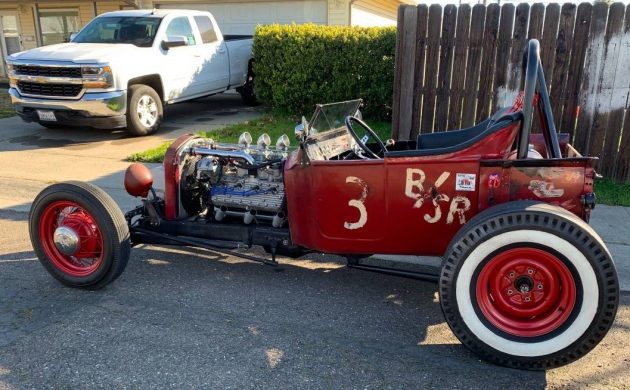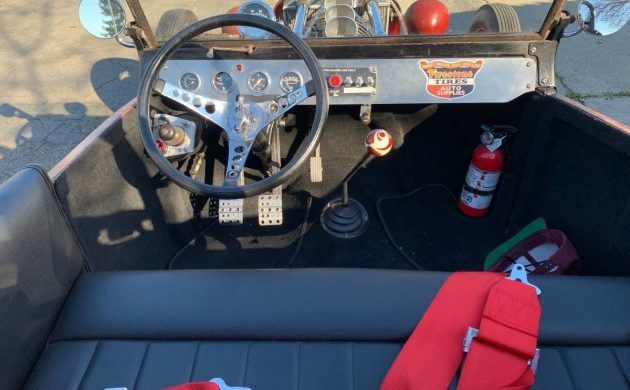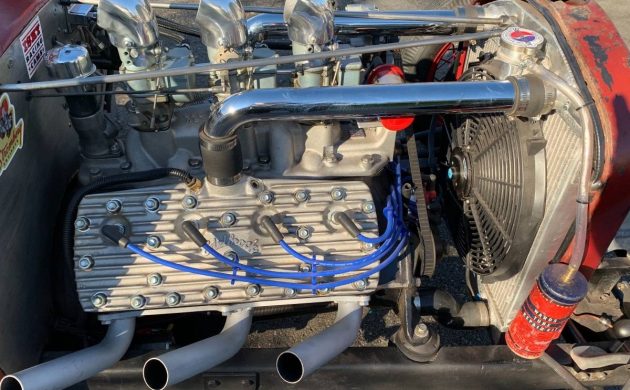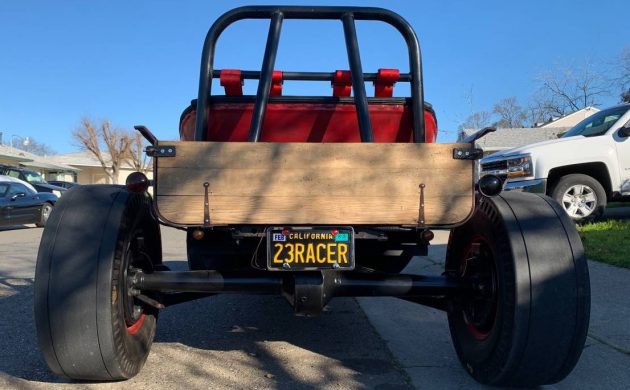I’m guessing Henry Ford realized pretty quickly that original buyers of his Model T cars and trucks were often converting his creations into some diverse applications to fit their own specific needs. Back in the early days, quite a few of these were turned into useful specialty vehicles such as farming tractors, firefighters, and even some railcars. But I doubt Henry ever envisioned that on down the line a craze known as rat-rodding would sweep the car enthusiast community, or that the platform his Model T provided would become such a popular choice as a starting point for conversion to a modern-day Rat Rod. If the thought of owning an unusual example of the latter appeals to you, this 1923 Ford Model T Roadster Pickup ex-drag racer might really whet your appetite. Located in Sacramento, California, it can be seen here on Craigslist with an asking price of $18,500. Barn Finds wants to thank reader T.J. for another great tip on this one.
Looking at it now, it’s kind of hard to believe that this Model T Roadster Truck started out as something similar to this. Although it now bears little resemblance to the original, its conversion to a street-legal race car was done quite some time ago, as it was drag raced back in the late ’50s in the B/SR class in Washington state. There’s no word on how many races it won or anything else given about the vehicle’s history, but it sure looks like some stiff competition, and you’ve just got to love that section in the middle of the dash labeled, “For Racing Use Only”!
The seller says that the 301 stroked flathead V8 is almost new and has many modifications. He specifically mentions a SCAT crankshaft, Edelbrock heads and intake, an electronic distributor, and new water pumps. Glaring at that exhaust system, or I guess more accurately lack of exhaust system, I can just imagine what an earthshaking and intimidating sound those upward-pointing pipes must produce! The engine is connected to a rebuilt ’39 Ford Mercury 3-speed transmission and there’s a ’40 axle out back with 3.54 gears. All that power is transmitted to a pair of Hurst pie-cut cheater slicks in the rear, and up front there are ’35 wire wheels with new bias-ply tires.
While it’s unlikely to be destined as a frequent driver for anybody, this ’23 would fit the bill nicely for an occasional weekend cruiser or as an oddity to drive up in at your local Cars And Coffee on Saturday mornings. What are your thoughts on this 1923 Ford Model T Roadster Pickup Drag Racer?






Back in the day I loved these old T’s, especially if they were made out of the original steel. Can’t think of anything I would change except take the front wheels and put them on my ’35 truck, and put a set of later 16’s on this one. I’m already deaf enough so I don’t need the zoomies; I would mount a set of headers and have them feed into a pair of (possibly) legal mufflers. And drive it I would…
NOT a “ rat rod”… pretty much a traditional “ HOTROD” 😁😎!….except for the electric fan😲…..
Non functioning drivers door tells me this is not Henry steel but a fiberglass tub. Also this is not a rat rod but an old school hot rod that looks pretty honest for what it is. I had an actual 27 steel bodied tub and I drove the wheels off it, although it was tight inside for me to drive it was a lot of fun.
Most T open bodies have the dummy driver’s door since on a stock one there are levers blocking the way so it wouldn’t be useful anyway. Exception is Canadian-built cars since they also supplied right-hand-drive markets, maybe that’s what you had?
My 27 was Canadian as am I. All the steel buckets and tubs I saw had opening doors both sides.
I have a friend over in Conrad who had a stable full of Model Ts, probably half he got out of Saskatchewan, Canada. He said that there were two distinct features on a Canadian T: 1/ A Left front door, and 2/ Robertson head screws in the body panels.
Oh yes, I can’t forget that it might have a dead giveaway stamped into the radiator shell…
Henry didn’t want a drivers side door on the car as he thought it was too dangerous for the driver to step out onto the street. I’m not sure anyone was making fiberglass T bodies in the 50’s.
It’s a shame that it doesn’t seem to come with any history; I have losts pertaining to both of the racecars that I’ve been involved with, and copies of results sheets and so on went with the one that I sold.
This is a breath of fresh air considering this is not the usual mess we normally see called a Rat Rod. I can’t confirm a steel body or glass but everything else looks the part. I can forgive it.This looks like it was built in the 50’s and 60’s.
This is not something gathered from a swap meet of Chevy junk laying around everywhere you look. Nothing says “Rat Rod jumped the shark more with a wore out 305 with an HEI and more Speedway catalog parts than you can shake your finger at.
The model T did not have an opening driver’s door until 1926. Before that, there was a molded in impression into the steel on that side. Take a look at photos, only the passenger side has hinges.
I remember a few of these back from my high school days. Fun for around town to goof off, but impractical to say the least. Handled atrociously. The guys I knew who had them, didn’t keep them long, soon handed off to the next dreamer.
Mike, you seem surprised that it’s street legal. If it’s titled as a ’23, the only equipment necessary to be street legal is 2 headlights, one taillight, and a horn. There weren’t many requirements in those days.
well i mean it does have a cali plate
Once again writers at Barnfinds. WORDS MATTER Do your research, not a Ratrod this is a Traditional Hotrod. Please get some informed writers.
Street legal cars in California (at least in the ’50s & ’60s, were required to be fendered – and anyone who ever drove an open ‘rod like this would tell you that uncovered tires will beat the crap out of you with debris tossed up off the street – also at least one working windshield wiper cleaning the driver’s side.
If the flatmotor is a 301 cu. in. as mentioned, then it’s a .030 overbore 3.3/8ths by 3/8th stroked crank inside and by mid ’50s-early ’60s NHRA rules, it would run as an A/SR with that many cubic inches and so little weight. The Hurst slicks were produced by Ronnie Hurst in San Diego from early 1960 until late 1977 when Ron moved his tire recapping business to Idaho.
Hey Jay, There is no hard and fast rule about Rat Rods. Being a self proclaimed “informed writer” you can decide what you think it means to you. Is this one? Sure. Is it a Hot Rod? Sure. Is it a Bucket T? Flivver? Gowjob? Yup. It could be any of those if the owner wants it to be. Who cares? Not me. https://www.dictionary.com/e/slang/rat-rod/ Terry J
As usual a lot of information not based on fact. I think this is not what the seller thinks it is. I doubt it has any significant history to early Hot Rods , other than its look and the Flathead. There is value in some of the parts ie: engine ,trans and rear end. But that wouldn’t get you to the asking price. As far as age, you didn’t see this style T-Bucket before Norm Grabowski’s car circa 1955 and Tommy Ivo’s car a little later. This look got popular in the 60’s. Also, Evan are you talking street legal in Mexico, because that’s the only place, I can think of that has that lax on safety issues. When I was a teenager the safety inspections in some ways were harder, than they are now. Especially in re guard to fenders and ride height and exhaust and mufflers and blue dot tail lights. It was very common for police to stop you and write tickets on the spot or even impound your car. I know this first hand! Again I hate to be a nay sayer, but not everything you heard about the good old days is absolutely true. Not saying it wasn’t great, it just gets a little embellished.
To Joe and David S above: Yup Norm Grabowski is credited with “inventing” the first Bucket T Hot rod as we know it today. Being a Geezer, I remember it well from the magazines and TV. Not long ago I was on one of the old time TV channels watching the detective show “Peter Gunn”. In that episode Gunn was stuck out on a country road and to my surprise out of nowhere roared Norm and his T (as a bad guy) and chased Gunn around, cutting cookies, trying to run him down. I couldn’t believe my eyes. I just looked up the history of that car and it said that at that time California required fenders if the car was over 1500 lbs, but Norm’s car was just barely under. :-) Terry J
I agree with Jay, its a Traditional hotrod, not a rat. So cool too.
Terry and David, in a forum like this it is hard to make a comment and not be able to qualify your remarks, as they can be taken out of context. Everything everyone says has some fact it. California laws were not the same as every where else. Yes fenders were required if weight was over 1500 lbs.. If you think about that, that is a very light car and how do you prove it. Rat Rod is an interesting term and I was going to say a new term. However , I just saw that this is the Anniversary of Gray Baskerville’s death and that was 20 years ago. He is credited with first making the term popular , although some what of an open ended definition. I was a friend of Norm’s and I always considered him the father of the T-Bucket, but I don’t ever remember talking to him about it and what he thought. He was just a very interesting guy and known for cars, but he did so much else he was an artist and an Entertainer and actor. Also lots of fun to be around. Terry I do agree what difference does it make what you call it. Everybody has their own definition, if you don’t think so just ask a group of guys what a Hot Rod is to them.
Joe: Gosh,what a COOL thing to have known Normie Poo. LOL. He was not only a visionary and a great fabricator, but he was a very funny guy too. :-) Terry J
Anyone who really knew Grabowski knew him for what he was. There’s the legend and then there’s the man.
Can I ask why there are only 3 exhaust tubes coming from each head. The ad says it’s a v8 and I can see 4 spark plugs leads coming off each head so it
Ist be a v8
Middle two cylinders exhausted through the same passage on each side…
This is not a real Model T roadster pickup — it has been cobbled together using the front ‘tub’ from a phaeton (touring) and a modified (or fabricated) shortened box of unknown origin.
Somewhere in the lexicon, one must add, “Fad “T” referring to the thousands of knock-offs of Grabowski’s Kookie Car vision.
The thing about the one door, Henry was one of the smartest revolutionaries of the time. No door, no hinges and no latch mechnizim. Invest in the stamping of the drivers side body panel and vola, the production cost are down and price down. The aFORDable auto for the average working person. Not knowing the cost of door, hinges and latch but shurly came out on top. I have owned my 25 one door late 50’s mod roadster for 35 years Oh so fun.
About the “One Door” on the passengers side. If you are not little and skinny, getting in an early car (of many brands) by angling in and sliding past the steering wheel could be a challenge. Many OEM manufacturers and aftermarket suppliers offered a hinged steering wheel that helped the problem. My RaTT has a race car removable steering wheel (also a good anti theft device). Henry Ford addressed it simply. No drivers door. :-) Terry J